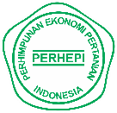Analisis Daya Saing Ekspor Teh Indonesia di Pasar Asia Tenggara Tahun 2012-2021
Abstract
Tea is one type of beverage that has many fans. In addition to having a distinctive taste, tea is also beneficial for the body. The high demand makes tea one of the export commodities in various countries, especially Indonesia. The area of tea plantations in Indonesia makes Indonesia the second largest country as a tea exporter in Southeast Asia after Vietnam. The study aimed to determine the competitiveness and trend of Indonesian tea export competitiveness in the Southeast Asian market. The basic method uses descriptive analysis methods. Data uses secondary time series data obtained from various official sources such as ITC Trade Map, Food and Agriculture Statistics (FAOSTAT), and other sources of information obtained from books, articles, and journals. The analysis method uses Revealed Comparative Advantage (RCA) to determine the competitiveness of Indonesian tea commodity exports and the Export Competitiveness Index (ECI) method to determine the trend of Indonesian tea competitiveness. The study results showed an average RCA value> 1, which is 2.29, which means that Indonesian tea has strong competitiveness in the Southeast Asian market.
Keywords
Full Text:
PDFReferences
Aprita, S., & Adhitya, R. (2020). Hukum Perdagangan Internasional. PT Raja Grafindo Persada.
Badan Pusat Statistik Indonesia. (2022). Tabel/Indikator Perkebunan Indonesia. https://www.bps.go.id/subject/54/perkebunan.html
BPS-Statistics Indonesia. (2023). Statistical Yearbook of Indonesia 2022. BPS-Statistics Indonesia. https://www.bps.go.id/publication/2022/02/25/0a2afea4fab72a5d052cb315/statistik-indonesia-2022.html
FAOSTAT. (2022). Domain Data. https://www.fao.org/faostat/en/#data
Fortunisa, A., Rikin, M. T., Ambarwati, I. T., Taufiq, R. I., & Hasyim, F. (2018). Analisa Positioning Thai Tea Dengan Studi Kasus Pada Merek Dum Dum, Tuk Tuk Cha Dan Think Thai.
Jannati, F., Marsudi, E., & Fauzi, T. (2020). Analisis Daya Saing Ekspor Teh Indonesia dan Teh Vietnam di Pasar Dunia. Jurnal Ilmiah Mahasiswa Pertanian, 5(1), 181–190.
Lindung, L., & Jamil, A. S. (2018). Posisi Daya Saing Dan Tingkat Konsentrasi Pasar Ekspor Karet Alam Indonesia Di Pasar Global. Jurnal AGRISEP : Kajian Masalah Sosial Ekonomi Pertanian Dan Agribisnis, 17(2), 119–128. https://doi.org/10.31186/jagrisep.17.2.119-128
Meilani, M. N., Fitriana, D., Ardipa, L., & ... (2024). Analisa Peluang Dan Ancaman Perdagangan Bebas Sektor Perkebunan (Indonesia-Malaysia-Vietnam). Jurnal Ekonomi Dan …, 01(04), 1111–1115.
Sembiring, B. S., Syaukat, Y., & Hastuti. (2021). Struktur Pasar Dan Daya Saing Karet Alam Indonesia Di Amerika Serikat. Buletin Ilmiah Litbang Perdagangan, 15(2), 235–256. https://doi.org/10.30908/bilp.v15i2.623
Sidabalok, S. (2018). Analisis Faktor-Faktor Yang Mempengaruhi Ekspor Komoditas Teh Indonesia. Jurnal Penelitian Pendidikan Sosial Humaniora, 2(2), 276–281. https://doi.org/10.32696/jp2sh.v2i2.67
Trevisanato, S. I., & Kim, Y.-I. (2000). Tea and health. Nutrition Reviewes, 58(2), 1–10. https://doi.org/10.1111/j.1753-4887.2000.tb01818.x
Yang, C. S., & Landau, J. M. (2000). Effects of Tea Consumption on Nutrition and Health. American Society for Nutritional Sciences, 130(10), 2409–2412. https://doi.org/10.1093/jn/130.10.2409DOI: https://doi.org/10.20961/agrisema.v3i1.87516
Refbacks
- There are currently no refbacks.
Copyright (c) 2024 Sapto Sapto

This work is licensed under a Creative Commons Attribution 4.0 International License.
|













7.png)
8.png)
